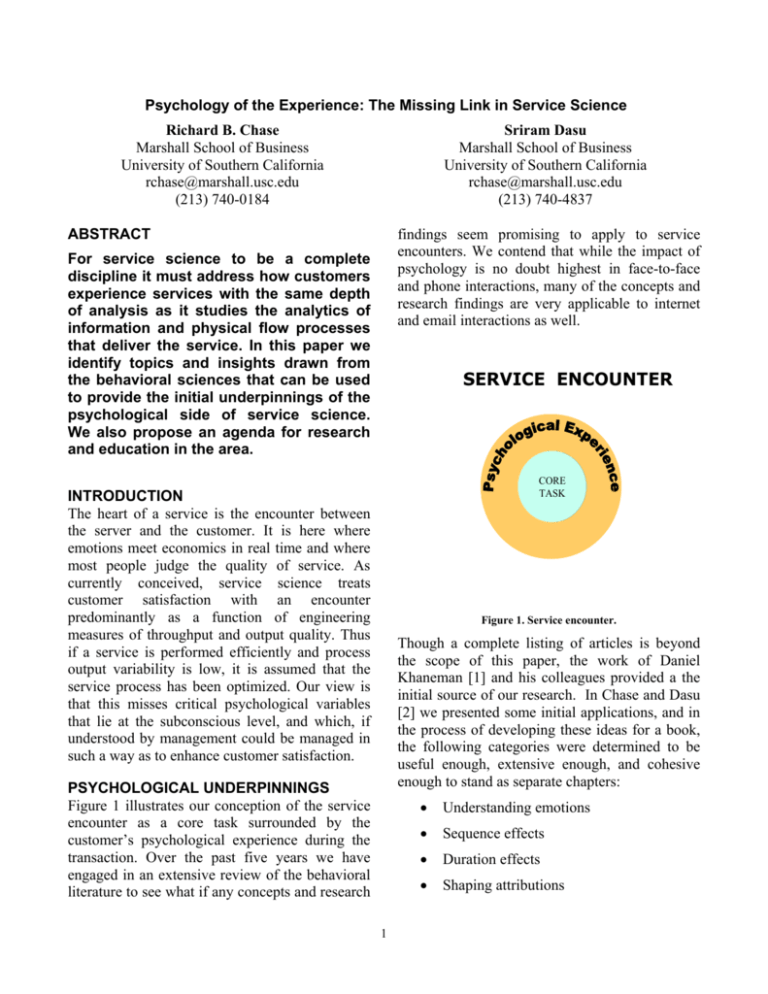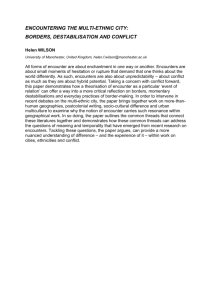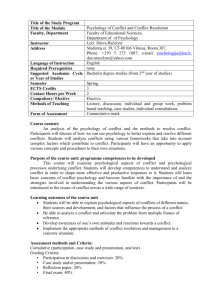service encounter
advertisement

Psychology of the Experience: The Missing Link in Service Science Richard B. Chase Marshall School of Business University of Southern California rchase@marshall.usc.edu (213) 740-0184 Sriram Dasu Marshall School of Business University of Southern California rchase@marshall.usc.edu (213) 740-4837 ABSTRACT findings seem promising to apply to service encounters. We contend that while the impact of psychology is no doubt highest in face-to-face and phone interactions, many of the concepts and research findings are very applicable to internet and email interactions as well. For service science to be a complete discipline it must address how customers experience services with the same depth of analysis as it studies the analytics of information and physical flow processes that deliver the service. In this paper we identify topics and insights drawn from the behavioral sciences that can be used to provide the initial underpinnings of the psychological side of service science. We also propose an agenda for research and education in the area. SERVICE ENCOUNTER CORE TASK INTRODUCTION The heart of a service is the encounter between the server and the customer. It is here where emotions meet economics in real time and where most people judge the quality of service. As currently conceived, service science treats customer satisfaction with an encounter predominantly as a function of engineering measures of throughput and output quality. Thus if a service is performed efficiently and process output variability is low, it is assumed that the service process has been optimized. Our view is that this misses critical psychological variables that lie at the subconscious level, and which, if understood by management could be managed in such a way as to enhance customer satisfaction. Figure 1. Service encounter. Though a complete listing of articles is beyond the scope of this paper, the work of Daniel Khaneman [1] and his colleagues provided a the initial source of our research. In Chase and Dasu [2] we presented some initial applications, and in the process of developing these ideas for a book, the following categories were determined to be useful enough, extensive enough, and cohesive enough to stand as separate chapters: PSYCHOLOGICAL UNDERPINNINGS Figure 1 illustrates our conception of the service encounter as a core task surrounded by the customer’s psychological experience during the transaction. Over the past five years we have engaged in an extensive review of the behavioral literature to see what if any concepts and research 1 • Understanding emotions • Sequence effects • Duration effects • Shaping attributions • focus on the peak event, the ending event, and the trend of a sequence. The implications of this for design are profound: in the way we present information, for example, in a call center (get the bad news out of the way first) to the way we conduct a class (end on a high note, or “stick the dismount”). Perceived control Understanding Emotions Emotions are both an input and an output of an encounter. Creating a good experience requires understanding what triggers different types of positive and negative emotions. This allows managers at an aggregate level to develop an emotional platform and at a tactical or process level to identify stages of the systems that are likely to engender strong emotions and to proactively manage them. A useful way of classifying emotional responses is through appraisal theory which specifies the conditions that result in different emotions as a result of change from a neutral emotional state. According to this theory, the type of emotion (positive or negative) we experience depends on whether the outcome: Duration Effects We all know that an hour is not an hour. How quickly it passes depends on a number of factors such as whether we are involved in pleasant or unpleasant activities, whether we are paying attention to the passage of time, how many segments the experience is divided into, etc. A big question is how do we make positive events seem longer and negative events shorter in retrospect? There is some evidence that the greater the number of discrete segments that are perceived to the customer, the longer the process appears. Thus for an amusement park visit, several shorter rides make the day seem longer and more enjoyable than a few longer rides, even though the time spent actually riding was the same. In a call center, more steps and options create the perception of the interaction being longer than it actually is. In general we find that perceived duration of a wait, or equivalently the level of dissatisfaction with a wait depends on (i) emotions and moods, (ii) rate of goal progress and evidence of goal progress, (iii) degree of perceived control, and (iv) attention paid to passage of time. Existing techniques for handling the psychology of waiting can be inferred from these four variables. These variables also suggest other techniques for improving the waiting experience. For instance, a call back option in call centers affords greater control to the customers. • • • • improves our situation or makes it worse, is associated with a penalty or a reward, is certain or just a possibility, is a significant / powerful event that is difficult to cope with or it’s not a very significant event and we can easily cope with the change, and • is caused by the individual or an outside agency A modification of the standard I.E. process map called an “experience print” can be used to analyze the variation in emotions throughout a service encounter. We can do this either through surveys or anticipate them by applying appraisal theory. Once we have a sense for potential emotions, we can introduce in to the process appropriate responses. The expectation is that we build in emotional intelligence in to the system. Sequence Effects Most service experiences consist of a series of events that occur over time. Lay tendency is to focus on a strong start and assume things will take care of themselves as the service encounter unfolds. At the other extreme we have service folklore that maintains every minute is significant. We now know that neither belief is accurate. According to numerous studies, people Shaping Attributions Every service outcome contains the potential for placing blame or claiming credit. Attribution theory provides insights into how people make these judgments. One such insight is that we are predisposed to accept responsibility for success and reject responsibility for failure. (Protecting one’s self-esteem is a dominate reason for such 2 initiatives. We also see an important role for IBM to play in these initiatives. attributions.) For service encounter design, we want to find ways of conveying up front what is the customers’ responsibility without damaging their self-esteem. Another insight is that we overestimate our ability to cause an outcome that is actually determined by chance. (We engage in counterfactual thinking--mental simulations--as to what might have been.) Often this is seen as the last step in an extended process and leads to the practical guideline that servers should avoid communicating near misses when dealing with a customer in situations when a constellation of factors resulted in the undesired final outcome. Interdisciplinary Research Conference on Service Psychology We propose that IBM partner with the Marshall School of Business and the Department of Industrial Engineering at USC to host an interdisciplinary conference on service psychology. The conference would invite leading researchers from psychology, consumer behavior, and sociology to provide overview sessions on the basics and recent developments in their fields of specialization. The audience would be researchers from business schools, engineering schools, and practitioners who are interested in SSME. We also propose that representatives from IBM, Oracle, and other high tech firms in the SSME group provide profiles of their customer touch points. This has the advantage of not only identifying where encounters occur but also uncovering subsets of encounters that may call for creating different and unanticipated applications of service psychology. This would also provide the basis for developing serviceware that incorporates psychological protocols. For example, automatically adjusting information event sequences to generate an upward trend in an internet encounter. Perceived Control In virtually every service encounter, customers must relinquish some control to the service firm to get the job done, yet customers like situations where they perceive they have some control. Research in many service settings has shown there is a relationship between perceptions of control and satisfaction. For example, studies in health care management have consistently shown that when patients have reasonable control over their treatment regimens, they are more satisfied than when doctors are in total control. In simple options such as allowing a patient to choose which arm from to draw blood from results in less feeling of pain than when ordered to draw blood from a specific arm. Even in intensive care situations, patients who are allowed to choose when they received visitors, when they eat and the level of exercise they could undertake, exhibit lower levels of stress and get well faster. Another form, and often a substitute for actual control is cognitive control where the customer feels she/he can rely on the system to work fairly. E.g., calls will be answered in order of arrival in a call center; or paychecks will be issued on the 15th of the month. When viewed this way, the concept of control can be approached in a more sophisticated way in planning service encounters. We envision a planning committee consisting of representatives from IBM and service research specialists from academia developing the specific behavioral science subtopics and issue areas to be addressed. We are particularly interested in new developments in applied computer science so we can incorporate service psychology into the design of 21st Century electronic encounters. Service Psychology Clearinghouse In addition to offering a kick-off conference to study the service psychology, we would also propose the establishment of a service psychology clearinghouse which would focus on applications that focus on high tech organizations and be managed by a postdoctoral scholar RESEARCH AND EDUCATION AGENDA This new way of looking at service encounters presents exciting opportunities for interdisciplinary research and educational 3 an opportunity to develop scientifically well grounded principles for design of service systems. Training the next generation of service “engineers” in these principles will add considerable value to the progress of service system design. working with us at the Marshall School. The goal would be to provide occasional newsletters on service psychology research and industrial applications. This information could be used to enrich service courses of virtually all types. Curriculum Development Service system design has relied on mathematical models to carefully match supply and demand. Queuing models have been used to anticipate queue lengths and work force requirements. In the last decade we have observed the emergence of dynamic pricing models that allow firms to manage demand. Dynamic pricing models can increase social welfare not just firm profitability. CONCLUSIONS Our ability to manage the psychological side of service encounters has lagged our ability to create the means by which encounters occur. Given the ubiquity of service encounters throughout all of industry, even just modest success in enhancing the practice of service psychology can have a huge impact on society. While we have developed rigorous approaches for managing supply and demand, the psychological dimensions of service encounters have not been approached with equal rigor. Focus has largely been on satisfaction and its antecedents. Our exploration of the social psychology literature suggests that there is now REFERENCES 1. Kahneman, Daniel and Amos Tversky, Choices, Values and Frames, Cambridge University Press, Cambridge, England, 2000. 2. Chase, Richard B. and Sriram Dasu, Want to Perfect Your Company’s Service? Use Behavioral Science,” Harvard Business Review, vol. 79, no. 6, June 2001, pp 78-85. 4




